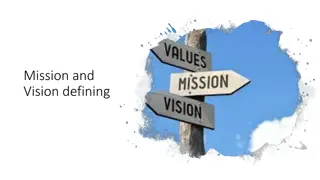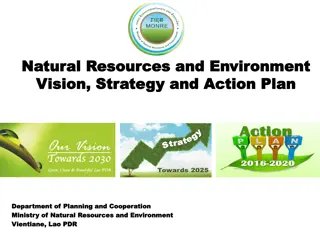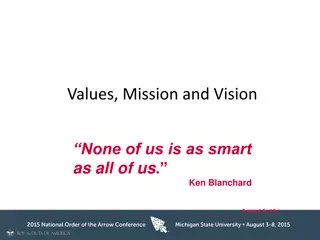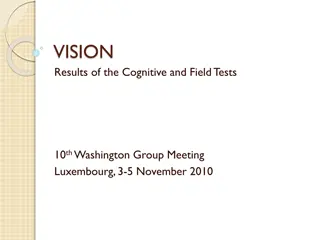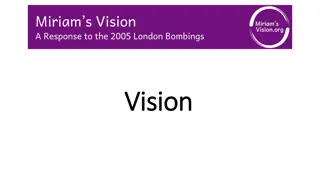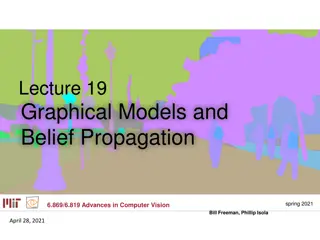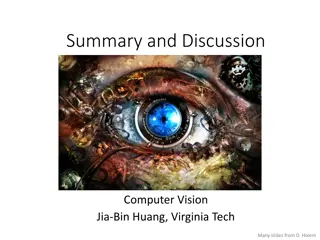Understanding the Importance of Vision in Business Management
Vision plays a crucial role in guiding organizations towards their desired future. It is a mental perception of the environment an entity aspires to create. Developing and sharing a vision across an organization fosters long-term thinking, risk-taking, and a shared sense of purpose. The benefits of a well-crafted vision include inspiring creativity, fostering innovation, and creating a common identity. This content discusses the characteristics, examples, and benefits of having a clear vision in business management.
Download Presentation

Please find below an Image/Link to download the presentation.
The content on the website is provided AS IS for your information and personal use only. It may not be sold, licensed, or shared on other websites without obtaining consent from the author. Download presentation by click this link. If you encounter any issues during the download, it is possible that the publisher has removed the file from their server.
E N D
Presentation Transcript
Disclaimer: The study material provided to our students of BBA/MBA of Department of Business Management is solely for the purpose of teaching and learning and has been obtained from varied sources. I do not claim for the originality of the content /resources/reading materials (PPTs, PDfs, You Tube Contents, Book Pdfs, Videos) shared as my own creation, as the contents/reading resources are a compilation from varied sources including open access sources and these are shared for the instructional and learning purpose by the students. I acknowledge and thankful to the sources, websites content writers and authors for their generosity in hosting their contents for wider dissemination and use. Dr. Rahil Yusuf Zai DoBM, IGNTU
Strategic Intent 1. Vision 2. Mission 3. Objectives 4. Goals
Vision Vision
Defining Vision description of something in the future mental perception of the kind of environment an individual, or an organization, aspires to create within a broad time horizon and the underlying conditions for the actualization of this perception
Vision It is what the firm or a person would ultimately like to become.
Examples BSNL Vision Statement To become the largest telecom service provider in Asia. Walt Disney vision Statement Make people happy Stokes Eye Clinic, Florence, South Carolina Our vision is to take care of your vision.
Characteristics 1. Vision is developed through sharing across an organization 2. Methods of convincing the others about vision
Benefits of having a vision Good visions are inspiring and exhilarating. Good vision foster long term thinking. Good vision foster risk-taking and experimentation. Good vision help in the creation of a common identity and a shared sense of purpose. Good visions are competitive, original and unique. Good visions represent integrity, they are truly genuine and can be used for the benefit of people.
Vision Statement A vision statement answers the question, What will success look like? The pursuit of this image of success is what motivates people to work together.
Example vision statement Infosys Vision To be a globally respected corporation that provides best-of-breed business solutions, technology, delivered by best-in-class people." leveraging
VISION Our Vision is to be the world s mobile communication leader customers lives, helping individuals, businesses and communities be more connected in a mobile world. enriching
Mission Mission
Mission Organizations relate their existence to satisfying a particular need of the society. They do it in terms of their mission. Mission is a statement which defines the role that an organization plays in a society. It refers to the particular need of that society for instance, its information needs.
Defining Mission essential purpose of the organization, concerning particularly why it is in existence, the nature of the business it is in, and the customers it seeks to serve and satisfy. purpose or reason for the organization s existence. mission is an enduring statement of purpose that distinguishes one firm from other similar firm.
In short the mission describes the product, market and technological areas of emphasis for the business.
Characteristics 1. Feasible 2. Precise 3. Clear 4. Motivating 5. Distinctive
Need for an explicit mission To ensure unanimity of purpose within the organization. To provide a basis for motivating the use of the organizations resources. To develop a basis, or standard, for allocating organizational resources. To establish a general tone or organization climate. To serve as a focal point for those who can identify with the organization s purpose and direction.
Mission Statement A mission statement is an enduring statement of purpose that distinguishes one business from other similar firms. A mission statement identifies the scope of a firm s operations in product and market terms.
BSNL mission To provide world class state of art technology telecom services to its customers on demand at competitive prices. To provide world class telecom infrastructure in its area of operation and to contribute to the growth of country s economy.
The mission statement of an organization is normally short, to the point, and contains the following elements: Provides a concise statement of why the organization exists, and what it is to achieve; States the purpose and identity of the organization; Defines the institution's values and philosophy; and Describes how the organization will serve those affected by its work.
Formulating mission 1. What is the basic purpose of your organization? 2. What is unique about your organization? 3. What is in your company that will make it stand out in a crowd? 4. Who are, and who should be, your principal customers? 5. What are the basic beliefs, values and philosophical priorities of your firm?
MISSION Driving in a wireless world Vodafone is primarily a user of technology rather than a developer of it, and this fact is reflected in the emphasis of our work programme on enabling new applications of mobile communications, using new technology for new services, research for improving operational efficiency and quality of our networks, and providing technology vision and leadership that can contribute directly to business decisions.
Infosys Mission "To achieve our objectives in an environment of fairness, honesty, and courtesy towards our clients, employees, vendors and society at large."
A Vision statement describes what the organization would like to become. A Mission statement describes what the organization is now. What the company is providing to society?
Ford sample vision statements Early 1900s: Democratize the automobile Current: To become the world's leading Consumer Company for automotive products and services. Honda sample vision statements 1970: We will destroy Yamaha Current: To Be a Company that Our Shareholders, Customers and Society Want
Example Mission Statements Wal-Mart "To give ordinary folk the chance to buy the same thing as rich people." Mary Kay Cosmetics "To give unlimited opportunity to women." 3M "To solve unsolved problems innovatively" Google's mission is to organize the world's information and make it universally accessible and useful.
Objectives Objectives
Objectives Objectives represent a managerial commitment to achieve specified results in a specified period, of time. They clearly spell out the quantity and quality of performance to be achieved, the time period, the process and the person who is responsible for the achievement of the objective.
Objectives are end results of planned activity Objectives state what is to be accomplished by when and should be quantified if possible.
Characteristics 1. Objectives form a hierarchy 2. Objectives form a network 3. Multiplicity of objectives 4. Long and short range objectives
Areas of objectives 1. Markets 2. Productivity 3. Innovation 4. Product 5. Profitability 6. Financial resources 7. Physical facilities 8. Organization structure and activities 9. Manager performance and development 10. Employee performance and attitude 11. Customer service 12. Social responsibility
Importance of objectives 1. Objectives help to define the organization in its environment 2. Objectives help in coordinating decisions and decision-maker 3. Objectives help in formulating strategies 4. Objectives provide standards for assessing organizational performance
Factors affecting Objectives 1. Forces in the environment 2. Internal forces 3. The value systems of the top executives
Goals Goals
Goal Goal is defined as an intermediate result to be achieved by a certain time as part of the grand plan . A plan can, there for have many goals.
Goals are short term (one year or less) milestones or bench marks that organizations must achieve in order for long term long term objectives to be reached. Goals should be measurable, quantitative, challenging, realistic, consistent and prioritized.
A set of goals is needed for each objective that is established in an organization.
Goals have the following features They: 1. Are derived from objectives 2. Offer a standard for measuring performance 3. Are expressed in concrete terms 4. Are time bound and work oriented.
Goals are important in Strategy implementation Objectives are in strategy formulation
Goals are an expected or desired outcome of a planning process. Goals are usually broad, general expressions of the guiding principles and aspirations of an organization. Objectives are precise targets that are necessary to achieve goals. Objectives are detailed statements of quantitatively or qualitatively measurable results the plan hopes to accomplish.






